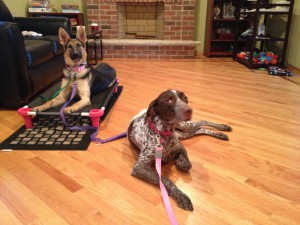I like to joke with my friends that I am absolutely ADDICTED to the show “Intervention”. They showcase addicts of all sorts. For some reason, I find it fascinating to watch a part of life I am so unfamiliar with. It’s probably because after watching them hit rock bottom, I hope so strongly in my heart that after their Intervention, they will work through their issues and attempt to live a healthier way of life. Who doesn’t love a great cry while watching a drug addict save themselves?! I do!
Recently I have been working with a wonderful retired couple. The husband is from Ireland and the wife is from New York. It really makes for fun conversations because I feel like I am on vacation enjoying other traveller’s accents. Not to mention, their lives are so interesting! They have a 2-year-old Shih Tzu named Edward. They adore Edward and say that everything is perfect about Edward BUT (if I had a penny every time I heard “I have a great dog but…”) he obsessively jumps on the wife, Joan. He is ADDICTED to her! (Intervention anyone?!) Every time that she gets up to walk around the house, he jumps up on her leg the entire time she is walking, never really letting his front paws touch the ground. It was driving her crazy, not to mention, putting her in fear that she may trip and fall. They were at their wits end, so they called me over. While I sat in their trendy living room, I observed Edward’s behavior. He immediately jumped on Joan’s lap and stayed there the entire time we talked, occasionally looking over at me. When she stood up, he jumped at her legs the entire time she walked and as she sat back down, he immediately jumped on her lap. Edward never went over to the husband, John. If I went over to Joan, Edward would get nervous and show his teeth at me, even lunging at me. They were shocked that he responded that way toward me. Poor Edward felt that he was protecting Joan. The jumping, in my professional opinion, was just a symptom of owner protective tendencies.Owner protective aggression relates to the dog’s perception that his owner is being threatened in some way. Because this is a perception, Edward’s response was to act out of context when there was no real threat, which is why he showed his teeth and lunged at me. This can indeed become a dangerous situation if left unfixed. The obsessive jumping was Edward’s constant way of getting her to pick him up or be on top of her in some way. It’s like he has to be right up in her space all the time. I think he feels safer being near her, but also feels a need to protect her.
Sometimes owners support this type of behavior without even knowing it. Joan has developed an intensely strong bond with Edward, which is wonderful! There is nothing wrong with intense bonds IF the owner still maintains a leadership role. It was clear to me that Joan and her husband were not in charge at their house: Edward was! They needed my help to reestablish their leadership roles in respect to Edward. How is this accomplished? Through an Intervention and change!
Joan understood that by letting Edward “protect” her, she was contributing to the situation. She had to let Edward know that she is just fine without him up her butt all the time. We started with not allowing Edward on her lap ALL the time. **New rule: He was off her lap more than on it. When she told him to get off, if he jumped back up, she had to push him off. This is more difficult than you think when you are so in love with the dog. She originally felt bad, like she was being mean by telling him to get off her. As her Interventionist, I had to tell her that by pushing him down doesn’t mean you love him any less. You are helping him to lesson his anxiousness. **New rule: Edward must learn how to walk at a heel at all times next to Joan and John. We reconditioned him to understand a new way of walking near her. We accomplished this by correcting his inappropriate jumping and rewarding his correct heeling. He caught on quicker than you would expect! **New rule: Edward had to spend time away from Joan. I had her lead Edward to her husband, John, more often. I had John bond with Edward by also giving him walks while heeling and cuddling with him instead of Joan. We also used the crate to allow the couple to enjoy some time without the dog near them 24/7.
Edward didn’t like all the new changes initially. He looked shocked! It was like he was in DETOX in Intervention! Doggie Druggie! He was coming off his drug of choice, Joan. He initially became a bit aggressive, but I assured Joan and John to remain CONSISTENT in their new ways. Edward was just testing them. If they allowed him to win even once, the likelihood of his old behaviors reoccurring would rise and rise.
It’s been two weeks since our 2nd visit. I called Joan this morning to check up on their progress and make sure she isn’t in the hospital from tripping over her dog. (if they didn’t follow through, that would have been a likelihood in their future!) I knew as long as they followed through with their consistent leadership skills, Edward’s anxiety would go down, equaling less need to protect, own, dominate.
As I sat here enjoying my morning coffee, I phoned Joan and listened to her boast at how well Edward has been doing. She sounded like a proud mother. Honestly, to me she appeared more confident in tone as well. She explained that Edward has been heeling much more often than not, she corrects him when he jumps on her (and she doesn’t’ feel bad), they crate him occasionally during the day, and can actually enjoy their walks outside without him pulling or jumping. They say he isn’t needing to be on her lap all the time and actually jumps on John’s lap too. If they push him down, he isn’t obsessively trying to figure out ways to get back up. He goes to his bed and lies down. They are actually really enjoying the process as well because their relationship is deepening, but in a healthy way.
Loving your dog is a beautiful thing. Your dog SHOULD trust you and feel safe near you. Being guided as to the proper time to reward one behavior and correct another will only strengthen the loving bond you have with your dog. We have ALL bawked at the screaming child in the store whose cries break down the parent, giving the child what they wanted. Guess what? The next time that child wants something, they know exactly what will work. Plus, guess what? I bet that child has already done that numerous times. Why? Because it worked! We condition behaviors in our dogs and we can recondition them to new ways. That is the beauty of repetitive, consistent new ways. This can all be done in a healthy, loving way that eventually becomes the only way.
If you or anyone you know could benefit from a doggie Interventionist, feel free to contact me. Take the first step towards recovery! I will now go back to my cup of coffee and finish up watching the crack addict on “Intervention” before my next training client. My favorite part of this show is watching them flourish at the end. :) I’ll get my Kleenex ready!

- How to Play With Your Dog: Part 1
- It Sounded Terrible!
- Voice Control
- I've Got This Feeling
- 4 Myths on Aggression in Dogs
- Doomed to Fail: Thoughts on "Padi"
- Welcome to Problem Solved! Dog Training
- Reducing Dog Stress During Christmas
- An Unexpected Litter, Puppy Expectations
- Behavior Intervention is Born
- Delaware - Where it All Started


